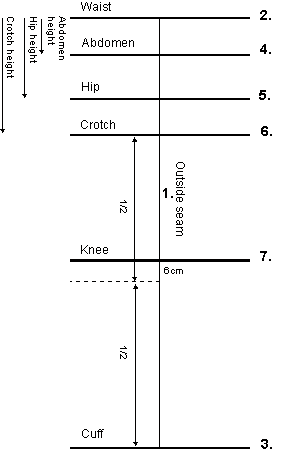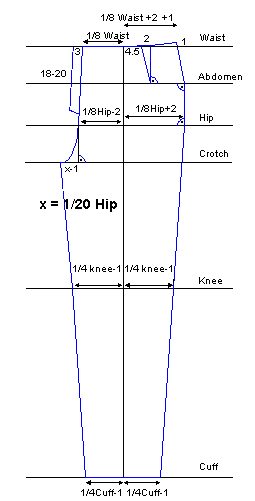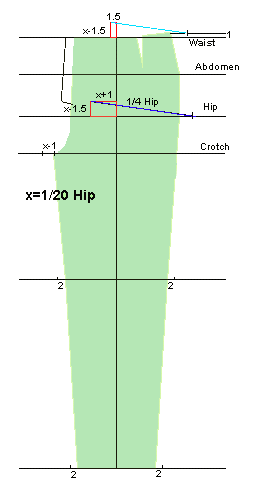Leena’s patns drafting instructions
This lesson shows how the patterns for the basic pants are drafted according to the Scandinavian pattern drafting system. They can be found at http://www.leenas.com/English/draw_women_pants.html
MEASURING
Read carefully the measuring instructions. To draft patterns for pants, you have to take the measurements listed in the table below. To keep the pictures clear and readable the measurements are given only in centimeters. You can change centimeters to inches using formula 1 cm = 0.4 inches.
ADDING EASE
You would not be able to wear the pants if the patterns were drawn exactly to your body measurements. Therefore you have to add ease to some of the measurements. The basic pants usually are a tight fitting garment and therefore only a small amount of ease is added.
ADD TO THE WAIST CIRCUMFERENCE: 2 cm ADD TO THE HIP CIRCUMFERENCE: 4 cm
Do not add any ease to other measurements. Write down the measurements in the table below.
Body measurement |
Body measurement + ease |
|
WAIST CIRCUMFERENCE |
* |
+2 cm= |
ABDOMEN CIRCUMFERENCE |
* |
|
HIP CIRCUMFERENCE |
* |
+ 4 cm= |
CROTCH DEPTH |
* |
|
ABDOMEN HEIGHT |
* |
|
HIP HEIGHT |
* |
+ |
OUTSIDE SEAM LENGTH |
* |
|
KNEE CIRCUMFERENCE |
* |
|
CUFF CIRCUMFERENCE |
* |
DO THE FOLLOWING CALCULATIONS:
Body measurement + ease |
Divided by 8 |
Divided by 4 |
Divided by 20 = x |
|
Waist circumference |
* |
* |
||
Hip circumference |
* |
* |
* |
* |
Knee circumference |
* |
* |
||
Cuff circumference |
* |
* |
Round the measurements up to the nearest 0.5 cm.
DRAFTING THE PATTERNS

Draw a frame first.
-
Start by drawing a vertical line that corresponds to the outside seam length of the pants.
-
Draw a horizontal line at the top of the vertical line. This is the waist line of the pants.
-
Draw a horizontal line at the bottom of the vertical line. This is the cuff line of the pants.
-
Measure down from the waist line a distance equal to the abdomen height and draw a horizontal line. This is the abdomen line.
-
Measure down from the waist line a distance equal to the hip height and draw a horizontal line. This is the hip line.
-
Measure down from the waist line a distance equal to the crotch height and draw a horizontal line. This is the crotch line.
-
Find the point midway between the crotch line and the cuff line. Draw the horizontal knee line 6 cm above this point.
FRONT PIECE

Waist and dart
Divide the waist circumference (+ ease) by 8. On the waist line, measure this distance to the
left from the pants' center line. Mark this point as the center front point of the waist.
Divide the waist circumference (+ease) by 8 and add 3 cm. On the waist line, measure this distance to the right from the pants' center line. Mark this point as the side front point of the waist. Of the extra 3 cm, +2 cm is for the dart and +1 cm is to move the side seams 1 cm towards the back to prevent them from showing. The side point is raised by 1 cm.
On the waist line, measure 4.5 cm to the right from the pants' center line and start the front dart from there. Make the dart 2 cm wide. The dart extends from the waist line to the abdomen line. Draw the right side of the dart so that it forms a right angle where it meets the abdomen line.
Hip
Divide the hip circumference (+ ease) by 8 and subtract 2 cm. On the hip line, measure this distance to the left from the pants' center line. Mark this point as the center front point of the hip.
Divide the hip circumference (+ ease) by 8 and add 2 cm. On the hip line, measure this distance to the right from the pants' center line. Mark this point as the side front point of the hip.
Draw a vertical line from the center hip point downwards to the crotch line and mark this point. From the marked point, measure x−1 cm to the left and mark. Mark this point as the tip of the front crotch curve. X is calculated by dividing the hip circumference (+ ease) by 20.
Knee and cuff
Divide the desired knee circumference by 4 and subtract 1 cm. On the knee line, measure this distance to the left and to the right from the pants' center line. Mark these points as the knee points of the front pant.
Divide the desired cuff circumference by 4 and subtract 1 cm. On the cuff line, measure this distance to the left and to the right from the pants' center line. Mark these points as the cuff points of the front pant.
Now you are ready to draft the front piece pattern. Follow the points that you have marked according to the above instructions. If the difference of the waist and the abdomen/hip circumference is a lot, there may be a disturbing angle at the side seam at the abdomen line.
In such a case round the line a bit outwards between the waist and the abdomen line (not marked in the picture). Curve the inseam a bit inwards between the crotch and the knee (not marked in the picture).
Draft the facing for the zipper, 3 cm wide and 18−20 cm high (according to the length of the zipper you are going to use), at the top of the front pant’s center line .
BACK PIECE
Draft the back piece pattern in the same frame with the front piece.

Waist points of the center back and the side back seam
Draw a small rectangle, 1.5 cm wide and x−1.5 cm high, to the left starting at the top of the pants' center line (drawn in red in the picture). Mark the top left corner of this rectangle as the waist point of the back center seam.
Divide the waist circumference by 4, add 2.5 cm and subtract 1 cm. Trace this distance from the previous point towards the waist line at side raised by 1 cm (as in the front) (drawn in cyan in the picture below). Of the distance +2.5 cm is for the dart and −1 cm is to move the side seams backwards (the corresponding amount was added to the front waist). Mark the intersection of this line and the waist line (raised by 1 cm, as for the front) as the waist point of the back side seam.
Hip points of the center back and side back seams
Draw another rectangle, x+1 cm wide and x−1.5 cm high, to the left from the intersection of the hip line and the pants' center line. Mark the top left corner of this rectangle as the hip point of the back center seam.
Divide the hip circumference by 4. Trace this distance from the previous point towards the hip line at side (drawn in blue in the picture below). Mark the intersection of this line and the hip line as the hip point of the back side seam.
Back crotch
Measure a distance of x−1 cm to the left from the tip of the front crotch curve and 1−1.5 cm downwards from it. Mark this point as the tip of the back crotch curve. X is calculated by dividing the hip circumference (+ ease) by 20.
The knee and the cuff points of the back pant
Mark these points 2 cm to the left and to the right from the corresponding points of the front pant.
Now you are ready to draft the back piece pattern. Follow the points that you have marked according to the above instructions. Draft a smooth line from the waist point to the hip point. The abdomen line of the back pant starts from the intersection of the back side line and the frame abdomen line and is parallel to the hip line of the back pant.
Draw the back center seam smoothly according to the picture. Back dart is 2,5 cm wide. Place it at the
midpoint of the back waistline. Vertically the back dart extends to the midpoint between the abdomen and the hip height.
Note : Please notice that the back piece inseam length measured from the crotch to the knee is to be 1−1.5 cm shorter than that of the front inseam. The reason for this is that it reduces the amount of fabric under the buttocks in order to achieve a better fit of the back pant. You must stretch the back inseam from the crotch to the knee when attaching it to the front inseam.
Copyright 1998 Leena Lahteenmaki